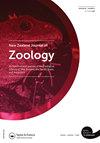A first synthesis of South America spider (Araneae) fauna: endemism, diversity, and taxonomy
IF 1.1
4区 生物学
Q3 ZOOLOGY
引用次数: 0
Abstract
Describing and understanding the diversity of South American spiders is a huge chal-lenge in many aspects, starting with the sheer number of species of a megadiverse group, and the geographic span and variety of habitats, from tropical rainforests, deserts, Pampas, to Valdivian temperate forests. Where do we stand in this titanic task? Nadine Dupérré ’ s (2022a) synopsis in this special issue provides a much-needed pause to examine the previous work and extract some conclusions and projections and provides a one-stop summary that will be useful for decades. I found enlightening, for example, her analysis of invasive species in and from South America, and how it relates to dispersal abilities and endemicity. After reading her summary, one feels (or hope), that we will see a large portion of the South American spider taxonomy nearly solved in our lifetime. How would that be possible? Spider taxonomists make a vibrant scienti fi c community (see Platnick and Raven 2013; Jäger et al. 2021), and we can be deservedly proud of important achievements, such as the World Spider Catalogue (World Spider Catalog 2022), an online resource professionally curated by an inter-national committee of expert collaborators, updated on a daily basis and providing access to all the taxonomic literature. Taxonomic expertise is especially alive in South America, probably because several countries have invested for many years in positions for arachnologists. This was e ff ectively re fl ected in the 557 participants in the last South American Congresses of Arachnology in Buenos Aires, 2020, of which about 110 were professionals based locally; there were about 150 regular presentations on systematics and biogeography of arachnids, an enviable number for a regional meeting. In the second contribution to this special issue, Dupérré (2022b) provides excellent illustrations of type-bearing specimens of the South American fauna preserved in Euro-pean collections, mainly those described by Eugène Simon and Lucien Berland in the Muséum National d ’ Histoire Naturelle南美洲蜘蛛区系的首次综合:特有性、多样性和分类学
描述和理解南美蜘蛛的多样性在许多方面都是一个巨大的挑战,从一个巨大多样性群体的物种数量,以及从热带雨林、沙漠、潘帕斯到瓦尔迪维亚温带森林的地理跨度和栖息地多样性开始。在这项艰巨的任务中,我们的立场是什么?Nadine Dupérré(2022a)在本期特刊中的简介提供了一个急需的停顿,以检查之前的工作,提取一些结论和预测,并提供了一站式的总结,将在几十年内有用。例如,她对南美洲和来自南美洲的入侵物种的分析,以及它与传播能力和地方性的关系,让我觉得很有启发性。在阅读了她的摘要后,人们感觉(或希望),我们将看到南美蜘蛛分类学的很大一部分在我们的有生之年几乎得到解决。这怎么可能呢?蜘蛛分类学家组成了一个充满活力的科学社区(见Platnick和Raven 2013;Jäger等人2021),我们理所当然地为重要成就感到骄傲,例如世界蜘蛛目录(2022年世界蜘蛛目录),这是一个由国家间专家合作者委员会专业策划的在线资源,每天更新,并提供对所有分类学文献的访问。分类学专业知识在南美洲尤其活跃,可能是因为几个国家多年来一直在投资蜘蛛学家的职位。这一点在2020年布宜诺斯艾利斯举行的上一届南美科学大会的557名参与者中得到了有效的反映,其中约110人是当地的专业人士;大约有150次关于蛛形纲动物的系统学和生物地理学的定期报告,这对于一次区域会议来说是一个令人羡慕的数字。在本特刊的第二篇文章中,Dupérré(2022b)提供了保存在欧洲泥炭地收藏中的南美动物群模式标本的优秀插图,主要是Eugène Simon和Lucien Berland在国家自然历史博物馆中描述的那些
本文章由计算机程序翻译,如有差异,请以英文原文为准。
求助全文
约1分钟内获得全文
求助全文
来源期刊
CiteScore
2.80
自引率
0.00%
发文量
20
审稿时长
>12 weeks
期刊介绍:
Aims: The diversity of the fauna of the southern continents and oceans is of worldwide interest to researchers in universities, museums, and other centres. The New Zealand Journal of Zoology plays an important role in disseminating information on field-based, experimental, and theoretical research on the zoology of the region.

 求助内容:
求助内容: 应助结果提醒方式:
应助结果提醒方式:


